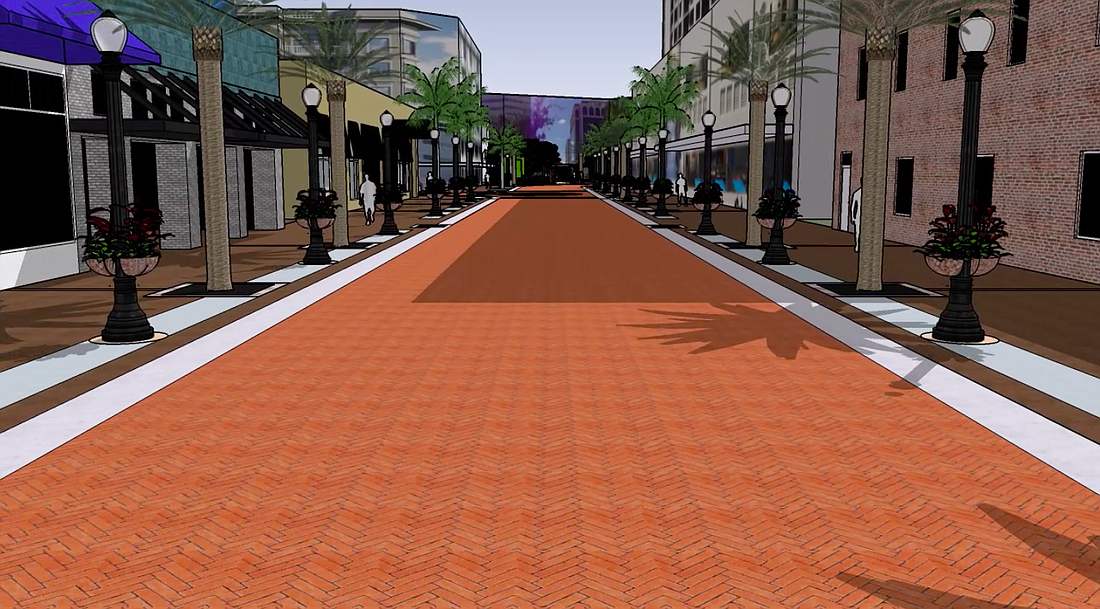- April 24, 2024
-
-
Loading

Loading

At an open house at City Hall on Monday, those in attendance mostly offered support for plans to redesign a segment of Lemon Avenue in downtown Sarasota.
In addition to renovating the streetscape to include bricked streets and curbless sidewalks between Main Street and Pineapple Avenue, the project includes changes at Paul Thorpe Park intended to create event space and encourage more activity in the area. Broadly speaking, the reactions to the proposal were positive.
“I think in general, the residents in the downtown area like the project,” said Patrick Gannon, president of the Downtown Sarasota Condominium Association.
There was at least one common point of contention, though: trees.
Even before Monday’s events, residents had raised concern about preliminary project designs that called for the removal of oak trees and the installation of palm trees. Those residents argued palm trees wouldn’t provide sufficient shade, which they called an essential component for a more walkable downtown.
“Just saying you get shade from the buildings or you get shade from awnings — that may provide some shade at some times of the day, but a well-planned canopy tree … can provide a great deal more local shade,” Gannon said.
Members of the project team said the palm trees were included for a reason. Although the city would prefer shadier trees where possible, oak trees haven’t thrived on the portion of Lemon Avenue between Main Street and First Street. Landscape architect Phil Smith, who the city is working with on the design of the project, said that’s because the trees were planted without enough space for the roots to grow.
In addition to stymied growth, planting bigger trees in confined spaces can cause the roots to push up the sidewalk, which has also happened downtown. Smith acknowledged there are root management systems that can facilitate the healthy growth of oak trees in urban settings, but even that needs a certain amount of space. Because the city has signaled a preference not to adjust the placement of underground utilities as part of this project, Smith believes oak trees aren’t the right fit.
“We’re trying to do something that’s sustainable,” Smith said.
Although those involved with the project reiterated the obstacles to planting shadier trees, opponents of the palm trees still believe there’s a way to make things work. Gannon was optimistic the city would be willing to seriously examine the costs and benefits of adjusting the design to incorporate canopy trees.
Barbara Campo, a downtown resident and advocate for more green space, also believed there was hope the city would adjust its plans.
“They’ve got to,” Campo said. “The people who love trees are crying for it.”
Smith said the design for the streetscape project is nearing 80% completion, but Monday’s event was held to gather public input to see if any changes are necessary. Jerry Fogle, the city’s parks and recreation director, said city leadership was willing to incorporate that input before beginning construction.
Fogle said contractor Jon F. Swift Construction is in the process of getting cost estimates for root management systems and replacing utilities. Although those involved with the project believe the changes would bring an additional expense, Fogle said the option will get fully vetted.
“We’re never going forward without as much input as possible,” Fogle said.
Beyond the Lemon Avenue trees, Fogle said he mostly heard positive feedback on the designs. He said residents were particularly receptive to the plans for Paul Thorpe Park, which include enhanced landscaping with more shade trees. The park will feature seating areas and game tables, part of the city’s efforts to encourage more activity in its downtown pocket parks.
Construction on the project is scheduled to begin in May and last through November.